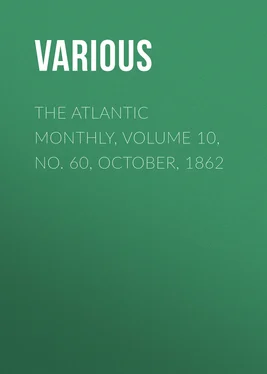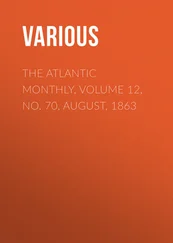Various - The Atlantic Monthly, Volume 10, No. 60, October, 1862
Здесь есть возможность читать онлайн «Various - The Atlantic Monthly, Volume 10, No. 60, October, 1862» — ознакомительный отрывок электронной книги совершенно бесплатно, а после прочтения отрывка купить полную версию. В некоторых случаях можно слушать аудио, скачать через торрент в формате fb2 и присутствует краткое содержание. Жанр: foreign_antique, periodic, foreign_edu, на английском языке. Описание произведения, (предисловие) а так же отзывы посетителей доступны на портале библиотеки ЛибКат.
- Название:The Atlantic Monthly, Volume 10, No. 60, October, 1862
- Автор:
- Жанр:
- Год:неизвестен
- ISBN:нет данных
- Рейтинг книги:3 / 5. Голосов: 1
-
Избранное:Добавить в избранное
- Отзывы:
-
Ваша оценка:
- 60
- 1
- 2
- 3
- 4
- 5
The Atlantic Monthly, Volume 10, No. 60, October, 1862: краткое содержание, описание и аннотация
Предлагаем к чтению аннотацию, описание, краткое содержание или предисловие (зависит от того, что написал сам автор книги «The Atlantic Monthly, Volume 10, No. 60, October, 1862»). Если вы не нашли необходимую информацию о книге — напишите в комментариях, мы постараемся отыскать её.
The Atlantic Monthly, Volume 10, No. 60, October, 1862 — читать онлайн ознакомительный отрывок
Ниже представлен текст книги, разбитый по страницам. Система сохранения места последней прочитанной страницы, позволяет с удобством читать онлайн бесплатно книгу «The Atlantic Monthly, Volume 10, No. 60, October, 1862», без необходимости каждый раз заново искать на чём Вы остановились. Поставьте закладку, и сможете в любой момент перейти на страницу, на которой закончили чтение.
Интервал:
Закладка:
THE RED MAPLE
By the twenty-fifth of September, the Red Maples generally are beginning to be ripe. Some large ones have been conspicuously changing for a week, and some single trees are now very brilliant. I notice a small one, half a mile off across a meadow, against the green wood-side there, a far brighter red than the blossoms of any tree in summer, and more conspicuous. I have observed this tree for several autumns invariably changing earlier than its fellows, just as one tree ripens its fruit earlier than another. It might serve to mark the season, perhaps. I should be sorry, if it were cut down. I know of two or three such trees in different parts of our town, which might, perhaps, be propagated from, as early ripeners or September trees, and their seed be advertised in the market, as well as that of radishes, if we cared as much about them.
At present, these burning bushes stand chiefly along the edge of the meadows, or I distinguish them afar on the hill-sides here and there. Sometimes you will see many small ones in a swamp turned quite crimson when all other trees around are still perfectly green, and the former appear so much the brighter for it. They take you by surprise, as you are going by on one side, across the fields thus early in the season, as if it were some gay encampment of the red men, or other foresters, of whose arrival you had not heard.
Some single trees, wholly bright scarlet, seen against others of their kind still freshly green, or against evergreens, are more memorable than whole groves will be by-and-by. How beautiful, when a whole tree is like one great scarlet fruit full of ripe juices, every leaf, from lowest limb to topmost spire, all aglow, especially if you look toward the sun! What more remarkable object can there be in the landscape? Visible for miles, too fair to be believed. If such a phenomenon occurred but once, it would be handed down by tradition to posterity, and get into the mythology at last.
The whole tree thus ripening in advance of its fellows attains a singular preeminence, and sometimes maintains it for a week or two. I am thrilled at the sight of it, bearing aloft its scarlet standard for the regiment of green-clad foresters around, and I go half a mile out of my way to examine it. A single tree becomes thus the crowning beauty of some meadowy vale, and the expression of the whole surrounding forest is at once more spirited for it.
A small Red Maple has grown, perchance, far away at the head of some retired valley, a mile from any road, unobserved. It has faithfully discharged the duties of a Maple there, all winter and summer, neglected none of its economies, but added to its stature in the virtue which belongs to a Maple, by a steady growth for so many months, never having gone gadding abroad, and is nearer heaven than it was in the spring. It has faithfully husbanded its sap, and afforded a shelter to the wandering bird, has long since ripened its seeds and committed them to the winds, and has the satisfaction of knowing, perhaps, that a thousand little well-behaved Maples are already settled in life somewhere. It deserves well of Mapledom. Its leaves have been asking it from time to time, in a whisper, "When shall we redden?" And now, in this month of September, this month of travelling, when men are hastening to the sea-side, or the mountains, or the lakes, this modest Maple, still without budging an inch, travels in its reputation,—runs up its scarlet flag on that hill-side, which shows that it has finished its summer's work before all other trees, and withdraws from the contest. At the eleventh hour of the year, the tree which no scrutiny could have detected here when it was most industrious is thus, by the tint of its maturity, by its very blushes, revealed at last to the careless and distant traveller, and leads his thoughts away from the dusty road into those brave solitudes which it inhabits. It flashes out conspicuous with all the virtue and beauty of a Maple,— Acer rubrum . We may now read its title, or rubric , clear. Its virtues , not its sins, are as scarlet.
Notwithstanding the Red Maple is the most intense scarlet of any of our trees, the Sugar-Maple has been the most celebrated, and Michaux in his "Sylva" does not speak of the autumnal color of the former. About the second of October, these trees, both large and small, are most brilliant, though many are still green. In "sprout-lands" they seem to vie with one another, and ever some particular one in the midst of the crowd will be of a peculiarly pure scarlet, and by its more intense color attract our eye even at a distance, and carry off the palm. A large Red-Maple swamp, when at the height of its change, is the most obviously brilliant of all tangible things, where I dwell, so abundant is this tree with us. It varies much both in form and color. A great many are merely yellow, more scarlet, others scarlet deepening into crimson, more red than common. Look at yonder swamp of Maples mixed with Pines, at the base of a Pine-clad hill, a quarter of a mile off, so that you get the full effect of the bright colors, without detecting the imperfections of the leaves, and see their yellow, scarlet, and crimson fires, of all tints, mingled and contrasted with the green. Some Maples are yet green, only yellow or crimson-tipped on the edges of their flakes, like the edges of a Hazel-Nut burr; some are wholly brilliant scarlet, raying out regularly and finely every way, bilaterally, like the veins of a leaf; others, of more irregular form, when I turn my head slightly, emptying out some of its earthiness and concealing the trunk of the tree, seem to rest heavily flake on flake, like yellow and scarlet clouds, wreath upon wreath, or like snow-drifts driving through the air, stratified by the wind. It adds greatly to the beauty of such a swamp at this season, that, even though there may be no other trees interspersed, it is not seen as a simple mass of color, but, different trees being of different colors and hues, the outline of each crescent tree-top is distinct, and where one laps on to another. Yet a painter would hardly venture to make them thus distinct a quarter of a mile off.
As I go across a meadow directly toward a low rising ground this bright afternoon, I see, some fifty rods off toward the sun, the top of a Maple swamp just appearing over the sheeny russet edge of the hill, a stripe apparently twenty rods long by ten feet deep, of the most intensely brilliant scarlet, orange, and yellow, equal to any flowers or fruits, or any tints ever painted. As I advance, lowering the edge of the hill which makes the firm foreground or lower frame of the picture, the depth of the brilliant grove revealed steadily increases, suggesting that the whole of the inclosed valley is filled with such color. One wonders that the tithing-men and fathers of the town are not out to see what the trees mean by their high colors and exuberance of spirits, fearing that some mischief is brewing. I do not see what the Puritans did at this season, when the Maples blaze out in scarlet. They certainly could not have worshipped in groves then. Perhaps that is what they built meeting-houses and fenced them round with horse-sheds for.
THE ELM
Now, too, the first of October, or later, the Elms are at the height of their autumnal beauty, great brownish-yellow masses, warm from their September oven, hanging over the highway. Their leaves are perfectly ripe. I wonder if there is any answering ripeness in the lives of the men who live beneath them. As I look down our street, which is lined with them, they remind me both by their form and color of yellowing sheaves of grain, as if the harvest had indeed come to the village itself, and we might expect to find some maturity and flavor in the thoughts of the villagers at last. Under those bright rustling yellow piles just ready to fall on the heads of the walkers, how can any crudity or greenness of thought or act prevail? When I stand where half a dozen large Elms droop over a house, it is as if I stood within a ripe pumpkin-rind, and I feel as mellow as if I were the pulp, though I may be somewhat stringy and seedy withal. What is the late greenness of the English Elm, like a cucumber out of season, which does not know when to have done, compared with the early and golden maturity of the American tree? The street is the scene of a great harvest-home. It would be worth the while to set out these trees, if only for their autumnal value. Think of these great yellow canopies or parasols held over our heads and houses by the mile together, making the village all one and compact,—an ulmarium , which is at the same time a nursery of men! And then how gently and unobserved they drop their burden and let in the sun when it is wanted, their leaves not heard when they fall on our roofs and in our streets; and thus the village parasol is shut up and put away! I see the market-man driving into the village, and disappearing under its canopy of Elm-tops, with his crop, as into a great granary or barnyard. I am tempted to go thither as to a husking of thoughts, now dry and ripe, and ready to be separated from their integuments; but, alas! I foresee that it will be chiefly husks and little thought, blasted pig-corn, fit only for cob-meal,—for, as you sow, so shall you reap.
Читать дальшеИнтервал:
Закладка:
Похожие книги на «The Atlantic Monthly, Volume 10, No. 60, October, 1862»
Представляем Вашему вниманию похожие книги на «The Atlantic Monthly, Volume 10, No. 60, October, 1862» списком для выбора. Мы отобрали схожую по названию и смыслу литературу в надежде предоставить читателям больше вариантов отыскать новые, интересные, ещё непрочитанные произведения.
Обсуждение, отзывы о книге «The Atlantic Monthly, Volume 10, No. 60, October, 1862» и просто собственные мнения читателей. Оставьте ваши комментарии, напишите, что Вы думаете о произведении, его смысле или главных героях. Укажите что конкретно понравилось, а что нет, и почему Вы так считаете.












